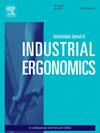AR vs. physical displays: Pharmacists’ performance in identifying look-alike drug names
IF 3
2区 工程技术
Q2 ENGINEERING, INDUSTRIAL
International Journal of Industrial Ergonomics
Pub Date : 2025-08-03
DOI:10.1016/j.ergon.2025.103794
引用次数: 0
Abstract
Similar drug name confusion poses a significant risk in pharmacy practice, leading to medication errors with serious consequences. This study investigates pharmacists’ performance in recognizing look-alike drug names using an augmented reality (AR) virtual display versus a physical liquid crystal display (LCD) monitor. The influence of prior AR experience on performance was also examined. Twenty licensed pharmacists participated, performing recognition tasks on similar drug name pairs, with performance measured by accuracy rate, response time, fixation duration, and total fixation count. Results indicate that participants achieved an accuracy rate exceeding 96 % across all conditions, with overall accuracy slightly higher in the physical monitor environment. The AR display enabled task completion with significantly fewer total fixations compared to the physical monitor (p < 0.05). Additionally, participants with prior AR experience exhibited faster response times and shorter fixation durations in the AR environment. There were interactions between environment and prior AR experience for response time and fixation duration, suggesting that performance across environments varied depending on user familiarity. While physical and AR displays each present unique advantages and limitations, these findings underscore the importance of user familiarity in adapting to emerging technologies in pharmacy practice.
AR与物理显示:药剂师在识别相似药物名称方面的表现
类似的药品名称混淆在药学实践中构成了重大风险,导致用药错误和严重后果。本研究调查了药剂师在使用增强现实(AR)虚拟显示器和物理液晶显示器(LCD)显示器识别相似药物名称方面的表现。我们还研究了先前AR经验对表现的影响。20名执业药师对相似的药品名称对进行识别,以正确率、反应时间、注视时间和总注视次数为衡量指标。结果表明,参与者在所有条件下的准确率都超过96%,在物理监测环境下的总体准确率略高。与物理显示器相比,AR显示器能够以更少的总注视完成任务(p <;0.05)。此外,具有AR经验的参与者在AR环境中表现出更快的反应时间和更短的注视时间。在响应时间和注视时间方面,环境和先前AR体验之间存在交互作用,这表明不同环境下的表现取决于用户的熟悉程度。虽然物理和增强现实各自显示出独特的优势和局限性,但这些发现强调了用户熟悉度在药房实践中适应新兴技术的重要性。
本文章由计算机程序翻译,如有差异,请以英文原文为准。
求助全文
约1分钟内获得全文
求助全文
来源期刊
CiteScore
6.40
自引率
12.90%
发文量
110
审稿时长
56 days
期刊介绍:
The journal publishes original contributions that add to our understanding of the role of humans in today systems and the interactions thereof with various system components. The journal typically covers the following areas: industrial and occupational ergonomics, design of systems, tools and equipment, human performance measurement and modeling, human productivity, humans in technologically complex systems, and safety. The focus of the articles includes basic theoretical advances, applications, case studies, new methodologies and procedures; and empirical studies.

 求助内容:
求助内容: 应助结果提醒方式:
应助结果提醒方式:


